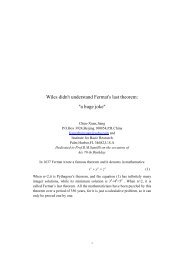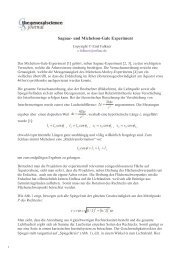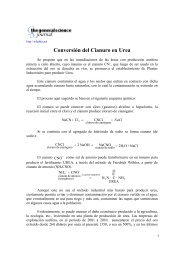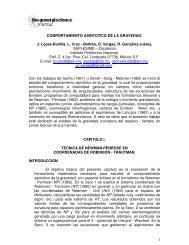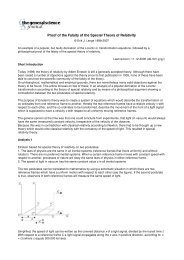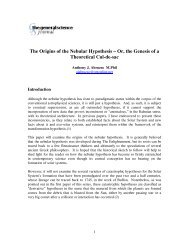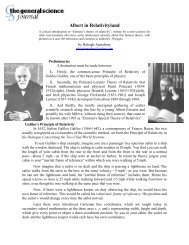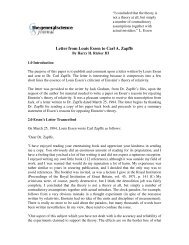MAGNETISM DURING THE SEVENTEENTH CENTURY HH Ricker III
MAGNETISM DURING THE SEVENTEENTH CENTURY HH Ricker III
MAGNETISM DURING THE SEVENTEENTH CENTURY HH Ricker III
Create successful ePaper yourself
Turn your PDF publications into a flip-book with our unique Google optimized e-Paper software.
Martin Lister’s theory which asserted that the principle of magnetism was embodied in the<br />
exhalation which formed iron pyrites (iron sulfide) seems peculiar from the modern viewpoint.<br />
But in terms of seventeenth century thought it is an interesting innovation. Lister, a disciple of<br />
Gilbert, was developing the Gilbertian magnetic philosophy. He was a mineralogist intent upon<br />
interpreting the mineral world in magnetic terms. By the 1680’s Lister had developed a theory<br />
for the origin of minerals based on his extension of Gilbert’s ideas. These ideas first appeared in<br />
print in the years 1682-1683, in his book De Fontibus Medicatis Angliae, which was privately<br />
printed. In this book, Lister asserted that all vitriolic minerals “arise out iron Pyrites”, by making<br />
it a fundamental explanatory substance within his system. Lister claimed pyrites was a concreted<br />
spirit of inflammable sulfur whose ignition was responsible for thunder and lightning, volcanoes<br />
and earthquakes. In the solid form its ignition produces pure iron and is the cause of magnetism.<br />
”Now, in order to know which metal possesses Pyrites, and how much, apply a Loadstone to it,<br />
when the metal has, of course, first been powdered and burnt, and the experiment will never<br />
deceive you.” 28<br />
Lister saw within iron pyrites the sulphurous principle of fire, and the result that its burned ash<br />
was magnetic (because it is iron) suggested to him the idea of the origin of magnetism.<br />
Lister’s theory resulted in an increased interest in magnetism that centered around the calcining<br />
of numerous substances in the search for magnetic properties. The reason for this is ambiguous.<br />
If magnetism was detected within the calcined powders, did this prove that the original body was<br />
magnetic or that the fire made the body magnetic? This seems to be the basis for a controversy<br />
between Lister and Robert Hooke. At Oxford, Lister’s theory aroused interest just as the Oxford<br />
Society was meeting for the first time in October 1683. The theory “gave occasion to a farther<br />
discourse concerning magnetism.” It was decided that John Ballard should undertake to answer<br />
the questions raised at the meeting. This initiated a renewed interest in the magnetic<br />
demonstrations of Henry Power performed many years earlier<br />
”Dr. Powers experiment was ordered to be tryed, viz: whether a bar of Iron heated, & when cold,<br />
struck violently will lose its polarity?” 28<br />
The experiments upon heating, cooling, and quenching as well as other mechanical<br />
manipulations were all retested and extended. The reason seems clear; to refute the origin of<br />
magnetism asserted in Lister’s theory. The mechanical philosophers were intent upon proving<br />
that the magnetism was due to some form of mechanical process, either by heat, or cold, or<br />
percussion, or any other mechanical means. When Robert Hooke learned of these experiments he<br />
resolved to provide an irrefutable demonstration of the mechanical origin of magnetism.<br />
The Controversy Over Magnetism And Lightning<br />
Returning to the year 1632, Pierre Gassendi discovered that a portion of the iron cross of the<br />
Church of Saint Jean at Aix had become magnetized after being struck by lightning. 23 The<br />
phenomenon was not unambiguous, because as had been described by Gilbert a magnetism had<br />
been imparted to an iron rod on the church of Saint Augustine at Arimini. The interpretation



